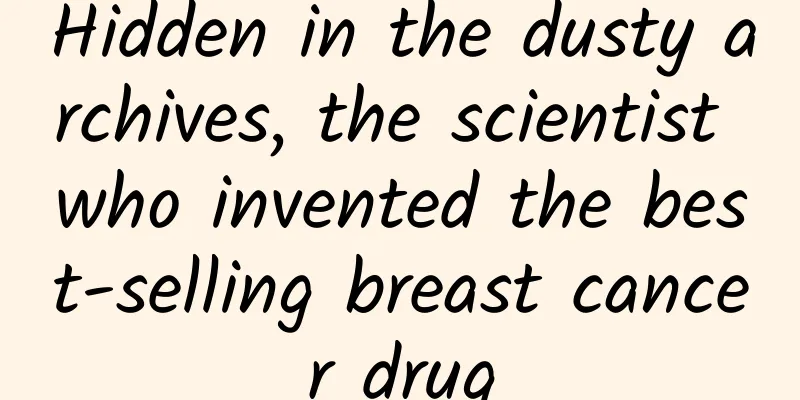Hidden in the dusty archives, the scientist who invented the best-selling breast cancer drug

|
In the process of scientific development, the contributions of many female scientists have been overlooked, and Dora Richardson is one of them. She is one of the inventors of the famous breast cancer drug, Tamoxifen, one of the most successful anti-cancer drugs. As an outstanding chemist, she worked for Imperial Chemical Industries for a long time, but her contribution was not known to the public due to her low-key personality and business strategy. It was not until people found the materials written by her in the archives that this legendary experience was unearthed. Dora Richardson is always worth remembering. Written by Gu Shuchen (Institute of Life Sciences, Zhejiang University) Throughout history, the outstanding contributions of many female scientists have been overlooked. Although they participated in the creation of history, they eventually became small footnotes in the history of science. This phenomenon is called the "Matilda effect", which refers to the fact that women's scientific achievements were ignored or resisted in their own time and attributed to their male counterparts. Although the names and deeds of some female scientists have become well-known to the public in recent years, such as Rosalind Elsie Franklin, who played a key role in revealing the double helix structure of DNA, the glorious deeds of many female scientists are still buried. Dora Richardson is one of them. She is the developer of Tamoxifen, one of the important drugs for treating breast cancer. What is tamoxifen? Breast cancer is a hormone-dependent tumor, and the growth of its cancer cells is promoted by estrogen. Therefore, the purpose of treating breast cancer can be achieved by regulating endocrine to inhibit the effect of estrogen. Tamoxifen (also known as tamoxifen) is one of the pioneering drugs for endocrine therapy of breast cancer. As a non-steroidal anti-estrogen drug, its structure is similar to that of estrogen, so it can replace estrogen and bind to estrogen receptors, thereby blocking the promotion of estrogen on breast cancer cells. Tamoxifen structure | Source: wiki Currently, tamoxifen has become one of the world's best-selling breast cancer drugs. It has been used in clinical practice for more than 40 years and has significantly reduced the global breast cancer mortality rate, allowing breast cancer patients to live longer and without recurrence. Especially for hormone receptor-positive/human epidermal growth factor receptor 2-negative (HR+/HER2-) breast cancer, it is currently considered to have a better prognosis, which is inseparable from the outstanding results achieved by tamoxifen in treatment. It is also the first drug approved by the U.S. Food and Drug Administration (FDA) for the prevention of breast cancer in high-risk women. It can reduce the risk of breast cancer by up to 40% and effectively reduce the incidence of breast cancer. Among all the four breast cancer prevention drugs currently approved, tamoxifen is the only drug approved by the U.S. FDA for the prevention of breast cancer in premenopausal women. The indications of other drugs are all postmenopausal medication. At the same time, tamoxifen is also approved for adjuvant treatment of breast cancer, which can significantly reduce the risk of postoperative recurrence [1]. In addition to treating breast cancer, as a pioneer of selective estrogen receptor modulators (SERMs), tamoxifen also provides a new drug template for the treatment of other diseases (such as osteoporosis and rheumatoid arthritis). Tamoxifen also plays an important role in gynecology and reproductive medicine. To date, research on tamoxifen is still ongoing, including the development of its derivatives to improve efficacy and reduce toxicity. From failed birth control pill to best-selling breast cancer drug Although tamoxifen has been widely used in clinical practice, its research and development process was not smooth. After World War II, the population explosion caused by the baby boom became a focus of politicians around the world. The demand for contraceptives was huge, and many pharmaceutical companies actively engaged in the research and development of contraceptives. It was in this context that tamoxifen was born in a contraceptive development project of Imperial Chemical Industries (ICI, the predecessor of AstraZeneca) in 1962. The project was led by endocrinologist Arthur Walpole and aimed to develop a drug that could resist estrogen to inhibit female ovulation, thereby achieving the effect of contraception. Dora Richardson was a member of the project. She successfully synthesized a compound called ICI 46,474, which is now known as tamoxifen. In rat experiments, the drug did show a contraceptive effect. However, in clinical trials, the drug did not show a contraceptive effect. Instead, it stimulated endometrial hyperplasia and promoted ovarian ovulation. This was very different from the company's original intention. Dora Richardson (1919-1998) | Image source: Reference [2] However, Walpole, a senior endocrinologist, noticed that ICI 46,474 had a striking similarity to the molecular structure of estrogen, so he speculated that this compound might have the potential to counteract estrogen and thus play a role in the treatment of breast cancer. At that time, the treatment of breast cancer was still mainly surgery, supplemented by chemotherapy. But with the advancement of science, endocrine therapy gradually began to emerge. As early as 1896, British scientist George Beatson successfully treated three patients with recurrent breast cancer by removing both ovaries to inhibit hormone secretion, marking an important milestone in the history of endocrine therapy for breast cancer [3]. In the 1940s, the estrogen drug diethylstilbestrol began to be used to treat postmenopausal patients with advanced breast cancer. Although there were side effects, its efficacy was significant. Walpole and Richardson then conducted preliminary experiments on the ICI 46,474 compound as a breast cancer treatment drug. Although the experimental results were good, the company was too conservative and unwilling to continue research and development. The reason was that this endocrine therapy method was still a very niche therapy at the time. If it was developed for the treatment of breast cancer, the sales of the drug would be very small. The company believed that this was not commercially feasible and was unwilling to take too much risk. In the end, ICI decided to stop the research. However, Dora Richardson, who originally synthesized the compound, and her boss Arthur Walpole were convinced that the drug had the potential to be developed into an anti-tumor drug that could save countless lives. Therefore, they decided to continue their semi-underground secret research. They used lunch breaks and afternoon tea time to conduct animal experiments in a dark basement room. Although Richardson had been transferred to other projects, she still took time to synthesize the tamoxifen needed for the experiment. After several months of secret research, Walpole became more convinced of the anti-cancer effect of tamoxifen and issued an ultimatum to ICI: either formally approve the tamoxifen research project or he would resign. Walpole was an authority in the field of reproductive endocrinology research at the time, and his influence in ICI could not be underestimated. The company's leaders had to seriously reconsider the prospects of this project. In the end, the project was able to continue partly because of their persistence, and Walpole also promoted another project: using tamoxifen as a treatment for breast cancer. The research team then conducted a clinical trial of tamoxifen for the treatment of breast cancer and saw positive results. In 1973, tamoxifen was successfully launched in the UK. Tamoxifen is mainly used as a palliative treatment for advanced breast cancer. Although the market size was limited at first, the subsequent joining of Craig Jordan brought new breakthroughs to the research. He not only explained how tamoxifen binds to estrogen receptors from a molecular mechanism and how this binding inhibits the growth of breast cancer cells, but also participated in and promoted a number of key clinical trials to verify the effectiveness of tamoxifen in the treatment of different stages of breast cancer, thereby expanding the application of tamoxifen to surgery, chemotherapy adjuvant treatment and breast cancer prevention for early breast cancer. Jordan's research has greatly broadened the application prospects of tamoxifen, and he is therefore known as the "Father of Tamoxifen." Since then, tamoxifen has transformed from a niche drug to a best-selling drug. Richardson and Walpole's persistence and hard work have finally paid off. They have not only brought new treatment hope to breast cancer patients, but also made an indelible contribution to the global breast cancer prevention and treatment. The Disappearance of Dora Richardson In the brilliant resume of tamoxifen, Dora Richardson was once forgotten, and her story was buried in the company's archives. In 2000, a medical history postdoctoral fellow named Viviane Quirke accidentally discovered the name Dora Richardson while researching the history of chronic disease drugs. At that time, ICI's pharmaceutical business unit had merged with AstraZeneca, but the relevant archives were still kept at ICI's headquarters. She came here to look up the information, and the archivist gave her a valuable 70-page document titled "The History of Nolvadex"; Nolvadex is the first brand name of tamoxifen. This document was written by Richardson when she retired in 1980, and it records in detail her feelings when researching tamoxifen and her hopes for the future. This document has never been published. She only handed it over to the company's archivist at the time along with many years of handwritten notes. Unfortunately, due to a clerical error in the archiving process - the key words "History of Nolvadex" were not included, this document has not been known to the world for the past twenty years [4]. Even Richardson wrote a short paper in 1988 describing the technical process, which was also sealed in the company archives. Now, with the rediscovery of these documents, Richardson's story on the development of tamoxifen can finally be known to the world. The History of Nolvadex Documents | Source: losttwomenofscience.org Dora Richardson was born in Wimbledon, south London in 1919. When she was a teenager, she went to the hospital to visit her dying grandmother. Perhaps she saw the hope that chemical drugs could treat cancer, and she set her mind to become a chemist. She was talented and supported by her family, so she was able to study chemistry at University College London (UCL). In an era of war and oppression of women, she still persisted in studying and graduated in 1941; later she received a doctorate in 1958. At that time, there were few opportunities for female chemists in the workplace. After two years of unremitting efforts, she finally got a precious position at ICI, working in the fertility research department under Walpole, engaged in the research and development of fertility regulation and cancer treatment drugs closely related to hormones. Richardson was truly extraordinary. In the scientific research of the time, women were generally only able to do some trivial assistant work, but Richardson was the only female member of the project and was responsible for chemical synthesis. This talented organic chemist not only successfully synthesized tamoxifen, but also isolated its corresponding isomer ICI 47,699. She conducted a detailed pharmacological characterization of the two molecules and surprisingly found that they had completely opposite pharmacological effects: tamoxifen showed significant anti-estrogenic activity, while ICI 47,699 showed estrogenic properties [5]. In addition, Richardson further revealed two important hydroxylated metabolites of tamoxifen - 4-hydroxytamoxifen and 3,4-dihydroxytamoxifen. In ligand binding assays in rats, mice and breast cancer tumor cytoplasm, these hydroxylated metabolites showed binding affinity comparable to estradiol (i.e., natural estrogen). This discovery was unprecedented in the scientific literature at the time, so much so that when the relevant research results were published, Dr. Richardson was asked to repeat the measurement to ensure that the accuracy of the experimental results was not due to dilution error.[6] These two crucial pharmacological discoveries provided solid theoretical support and experimental basis for subsequent in vivo experiments. Looking back at the entire development of tamoxifen, it is not difficult to see that Richardson is not only good at using drugs, but also has profound insight and forward-looking thinking. She carefully considered the possible development directions of drugs and how to best apply them to clinical practice. Richardson was an extremely humble and selfless scientist. Unlike other chemists, she did not actively promote new drugs, frequently attend various academic conferences and give speeches. On the contrary, she was more willing to work quietly and selflessly, and she worked diligently at ICI throughout her life. Although she cheered like a child every time she received a thank-you letter from patients who successfully defeated breast cancer after receiving tamoxifen treatment, she never put personal fame and fortune first. In addition, in the social environment at that time, female scientists often found it difficult to receive the same treatment and recognition as male scientists. Therefore, even though Richardson made extremely important contributions to the development of tamoxifen, her name was slowly forgotten by everyone. Today, we can only see her name on the patent of tamoxifen. postscript Fortunately, Richardson witnessed the profound impact of tamoxifen on women's health and the huge economic benefits that ICI gained from tamoxifen before she died. However, her boss Walpole failed to see the full picture of her work and died shortly after his retirement. In Walpole's hometown, there is a "Walpole Way" named after him to commemorate this great scientist. Today's scientific achievements are often the crystallization of collective wisdom. Whether it is a famous person or a small person who has made silent contributions; whether it is a talented woman or a hardworking man, their contributions should be fairly recorded in the archives of history. Jordan wrote in his book recalling the history of tamoxifen: "History moves forward, but it is written in retrospect." [7] Perhaps he is standing on Richardson's shoulders to look back at history, but we should not ignore the solid ground under his feet. Dora Richardson, a scientist who should not be forgotten, has made indelible contributions to human health with her outstanding talent, selfless dedication and perseverance. She deserves the respect and remembrance of every one of us. Special Tips 1. Go to the "Featured Column" at the bottom of the menu of the "Fanpu" WeChat public account to read a series of popular science articles on different topics. 2. Fanpu provides a function to search articles by month. Follow the official account and reply with the four-digit year + month, such as "1903", to get the article index for March 2019, and so on. Copyright statement: Personal forwarding is welcome. Any form of media or organization is not allowed to reprint or excerpt without authorization. For reprint authorization, please contact the backstage of the "Fanpu" WeChat public account. |
Recommend
Shine! Chinese Treasures ①丨The history of "China" is longer than you think
The word "China" refers to both China a...
"Large private domain traffic": How to play Douyin, WeChat circles, and sinking markets respectively?
At the end of 2019, I summarized and reflected on...
The bonus period of Douyin fans is coming, how can we take advantage of it?
Follow the flow , you will never go wrong. This s...
Apple's new patent: Apple Ring can control smart home through gestures
Apple has reportedly released a new patent that s...
GSMA: China's 5G connections are expected to reach 865 million by 2025, accounting for 40% of the world's total
Statistics from GSMA Think Tank, a GSMA research ...
Who stole your users?
When we are doing product or brand marketing , it...
How many days will it take for something to happen if you sleep less than 6 hours a day?
【Written at the end】 If you sleep less than 6 hou...
Lanzhou mini program production and customization development, what are the processes for developing a mini program?
After the fifteenth day of the first lunar month,...
How long will humans continue to be tortured by these bad habits that cannot be changed even by “sex change” or injections?
Spring is here, and it’s here again… the season w...
Wu Hequan, Academician of the Chinese Academy of Engineering: In the next ten years, we will be in the "new Internet era"
As an important part of the 2025 Zhongguancun For...
10 kinds of food that nutritionists hardly eat, but you may be eating them every day!
There are many foods that nutritionists almost ne...
Gartner: Smartphone shipments saw the “worst decline ever” in the first quarter
The global smartphone market suffered its largest...
Is attracting new users a big problem? Maybe the wrong medicine was used.
What is user acquisition? "Attracting new us...
What is the Pomegranate Algorithm? How to deal with the pomegranate algorithm?
From the perspective of the entire Internet ecosy...
Tencent Advertising Platform Advertiser Violation Penalty Regulations!
I. Definition of advertiser violation Advertiser ...









